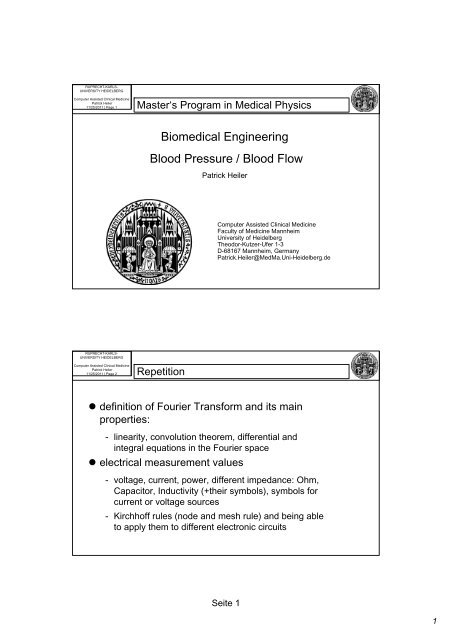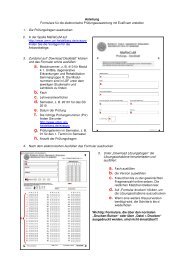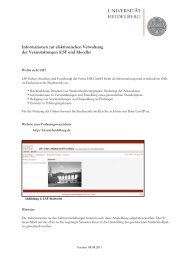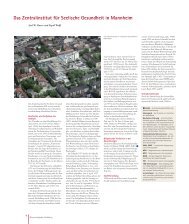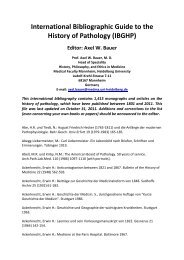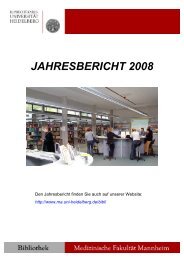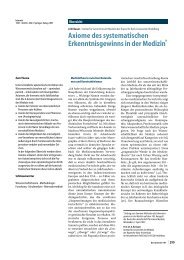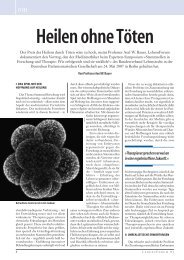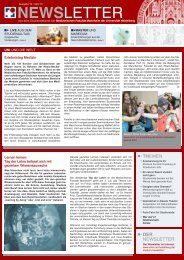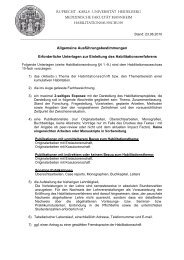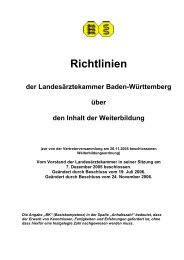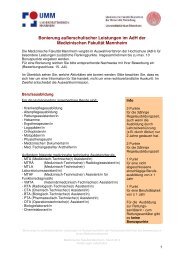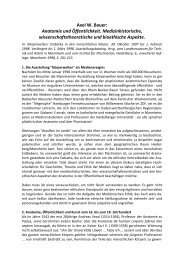Biomedical Engineering Blood Pressure / Blood Flow
Biomedical Engineering Blood Pressure / Blood Flow
Biomedical Engineering Blood Pressure / Blood Flow
Create successful ePaper yourself
Turn your PDF publications into a flip-book with our unique Google optimized e-Paper software.
RUPRECHT-KARLS-<br />
UNIVERSITY HEIDELBERG<br />
Computer Assisted Clinical Medicine<br />
Patrick Heiler<br />
11/25/2011 | Page 1<br />
Master‘s Program in Medical Physics<br />
<strong>Biomedical</strong> <strong>Engineering</strong><br />
<strong>Blood</strong> <strong>Pressure</strong> / <strong>Blood</strong> <strong>Flow</strong><br />
Patrick Heiler<br />
Computer Assisted Clinical Medicine<br />
Faculty of Medicine Mannheim<br />
University of Heidelberg<br />
Theodor-Kutzer-Ufer 1-3<br />
D-68167 Mannheim, Germany<br />
Patrick.Heiler@MedMa.Uni-Heidelberg.de<br />
RUPRECHT-KARLS-<br />
UNIVERSITY HEIDELBERG<br />
Computer Assisted Clinical Medicine<br />
Patrick Heiler<br />
11/25/2011 | Page 2 Repetition<br />
• definition of Fourier Transform and its main<br />
properties:<br />
- linearity, convolution theorem, differential and<br />
integral equations in the Fourier space<br />
• electrical measurement values<br />
- voltage, current, power, different impedance: Ohm,<br />
Capacitor, Inductivity (+their symbols), symbols for<br />
current or voltage sources<br />
- Kirchhoff rules (node and mesh rule) and being able<br />
to apply them to different electronic circuits<br />
Seite 1<br />
1
RUPRECHT-KARLS-<br />
UNIVERSITY HEIDELBERG<br />
Computer Assisted Clinical Medicine<br />
Patrick Heiler<br />
11/25/2011 | Page 3 Overview<br />
• Fluid Parameters: <strong>Pressure</strong>, <strong>Flow</strong><br />
• Fluids in Motion<br />
• <strong>Flow</strong> of Fluids in Tubes<br />
• <strong>Blood</strong> <strong>Pressure</strong><br />
• Measurement of <strong>Blood</strong> <strong>Pressure</strong><br />
• <strong>Pressure</strong> Sensor<br />
RUPRECHT-KARLS-<br />
UNIVERSITY HEIDELBERG<br />
Computer Assisted Clinical Medicine<br />
Patrick Heiler<br />
11/25/2011 | Page 4<br />
Fluid Parameters<br />
parameter<br />
Formula/Symbol<br />
SI unit<br />
Density:<br />
ρ=m/V<br />
[kg/m 3 ]<br />
Temperature<br />
Velocity<br />
v<br />
=<br />
d s<br />
dt<br />
T<br />
=<br />
⎛<br />
⎜<br />
⎜<br />
⎜<br />
⎝<br />
u<br />
v<br />
w<br />
⎞<br />
⎟<br />
⎟<br />
⎟<br />
⎠<br />
[K]<br />
[m/s]<br />
<strong>Pressure</strong><br />
p=F/A<br />
[N/m 2 ]<br />
Seite 2<br />
2
RUPRECHT-KARLS-<br />
UNIVERSITY HEIDELBERG<br />
Computer Assisted Clinical Medicine<br />
Patrick Heiler<br />
11/25/2011 | Page 5 <strong>Pressure</strong> Conversion Factors<br />
Atmosphere<br />
N/m 2 = Pa<br />
mm Hg<br />
mm H 2 O<br />
Atmosphere<br />
1<br />
1.01 x 10 5<br />
760<br />
10300<br />
N/m 2 = Pa<br />
9.87 x 10 -6<br />
1<br />
0.0075<br />
0.102<br />
mm Hg<br />
0.00132<br />
133<br />
1<br />
13.6<br />
mm H 2 O<br />
9.68 x 10 -5<br />
9.81<br />
0.0735<br />
1<br />
RUPRECHT-KARLS-<br />
UNIVERSITY HEIDELBERG<br />
Computer Assisted Clinical Medicine<br />
Patrick Heiler<br />
11/25/2011 | Page 6 <strong>Pressure</strong> in the Body<br />
Seite 3<br />
3
RUPRECHT-KARLS-<br />
UNIVERSITY HEIDELBERG<br />
Computer Assisted Clinical Medicine<br />
Patrick Heiler<br />
11/25/2011 | Page 7 Static <strong>Pressure</strong><br />
p stat = F/A;<br />
F<br />
A<br />
V<br />
H<br />
Fx<br />
⎛ ∂p<br />
⎞ ∂p<br />
∂p<br />
∂p<br />
= p ⋅dydz<br />
− ⎜ p + dx⎟dydz<br />
= − dV Fy<br />
= − dV , Fz<br />
= − dV<br />
⎝ ∂x<br />
⎠ ∂x<br />
∂y<br />
∂z<br />
r<br />
F = −grad<br />
p ⋅dV<br />
RUPRECHT-KARLS-<br />
UNIVERSITY HEIDELBERG<br />
Computer Assisted Clinical Medicine<br />
Patrick Heiler<br />
11/25/2011 | Page 8 Hydrostatic <strong>Pressure</strong><br />
Force of Gravity of volume element dV:<br />
pressure on ground element da:<br />
hydrostatic pressure distribution:<br />
dF = ρ ⋅ g ⋅dV<br />
, ⇒ dp = ρ ⋅ g ⋅ dz<br />
p<br />
p<br />
atm<br />
atm<br />
H<br />
(0) = ∫ ρ ⋅ g ⋅dz<br />
= ρ ⋅ g ⋅ H<br />
0<br />
H<br />
( h)<br />
= ∫ ρ ⋅ g ⋅ dz = ρ ⋅ g(<br />
H − h)<br />
h<br />
F<br />
A<br />
V<br />
H<br />
Seite 4<br />
4
RUPRECHT-KARLS-<br />
UNIVERSITY HEIDELBERG<br />
Computer Assisted Clinical Medicine<br />
Patrick Heiler<br />
11/25/2011 | Page 9 <strong>Flow</strong><br />
flow: Q = dV/dt = Av<br />
v 1 , A 1 v 2 , A 2<br />
dV = A ds = A v dt<br />
incompressible flow<br />
continuity law: Q = v 1<br />
A 1<br />
= v 2<br />
A 2<br />
= const<br />
general case: Q = V 1<br />
A 1<br />
+ Q source<br />
–Q drain<br />
RUPRECHT-KARLS-<br />
UNIVERSITY HEIDELBERG<br />
Computer Assisted Clinical Medicine<br />
Patrick Heiler<br />
11/25/2011 | Page 10 Bernoulli-Equation<br />
Potential Energy:<br />
ΔW =<br />
1 = F1Δx1<br />
= p1A1Δx<br />
1 p1V<br />
1<br />
ΔW =<br />
2 p2V<br />
2<br />
Kinetic Energy:<br />
Ekin<br />
=<br />
1<br />
2<br />
mv<br />
2<br />
1 2<br />
= ρv<br />
V<br />
2<br />
Conservation of Energy:<br />
1<br />
p1V<br />
1 +<br />
2<br />
v V<br />
p V<br />
2<br />
ρ 1 = 2 2 +<br />
1 2<br />
ρv<br />
V<br />
2<br />
1 2 1 2<br />
p 1 + ρv<br />
= p2<br />
+ ρv<br />
= const.<br />
2 2<br />
2<br />
Seite 5<br />
5
RUPRECHT-KARLS-<br />
UNIVERSITY HEIDELBERG<br />
Computer Assisted Clinical Medicine<br />
Patrick Heiler<br />
11/25/2011 | Page 11 Fluids in Motion I<br />
FF<br />
dv<br />
=η ⋅ A<br />
dr<br />
η ... viscosity<br />
F r<br />
⎡ NS ⎤<br />
⎢ 2 ⎥<br />
⎣ m ⎦<br />
v(r)<br />
A<br />
liquid<br />
Examples:<br />
fluid<br />
water<br />
blood<br />
glycerin<br />
mercury<br />
η [mNs/m 2 ]=[mPas]<br />
1.002<br />
approx. 3-5<br />
1480<br />
1.55<br />
T = 20°<br />
RUPRECHT-KARLS-<br />
UNIVERSITY HEIDELBERG<br />
Computer Assisted Clinical Medicine<br />
Patrick Heiler<br />
11/25/2011 | Page 12 Fluids in Motion II<br />
laminar current:<br />
frictional force > accelerating Force<br />
otherwise formation of turbulences possible (where velocity gradient is strong)<br />
distinction: Reynolds number:<br />
Re =<br />
ρ ⋅v ⋅ D<br />
η<br />
D ... characteristic length<br />
... tube diameter<br />
• laminar flow: Re < 2300<br />
• transient: 2300 < Re < 4000<br />
• turbulent flow: Re > 4000<br />
Seite 6<br />
6
RUPRECHT-KARLS-<br />
UNIVERSITY HEIDELBERG<br />
Computer Assisted Clinical Medicine<br />
Patrick Heiler<br />
11/25/2011 | Page 13 <strong>Flow</strong> of Fluids in Tubes I<br />
Due to symmetry the velocity of the current is only<br />
depended on the distance to the axis!<br />
p 1<br />
Frictional force and resulting pressure force on<br />
the end surfaces are in equilibrium.<br />
dv 2<br />
F = 2πrL<br />
⋅η<br />
= πr<br />
( p − p2)<br />
= F<br />
F<br />
1<br />
p<br />
dr<br />
dv p1 − p2<br />
<br />
= r<br />
dr 2ηL<br />
R<br />
p 2<br />
p1<br />
− p 2 p1<br />
− p 2<br />
2 2<br />
2 v(<br />
r)<br />
rdr = ⋅(<br />
R − r )<br />
= ∫<br />
2ηL<br />
4ηL<br />
r<br />
RUPRECHT-KARLS-<br />
UNIVERSITY HEIDELBERG<br />
Computer Assisted Clinical Medicine<br />
Patrick Heiler<br />
11/25/2011 | Page 14 <strong>Flow</strong> of Fluids in Tubes II<br />
<strong>Flow</strong>:<br />
Q =<br />
=<br />
R<br />
∫<br />
0<br />
R<br />
∫<br />
v(<br />
r)<br />
dA =<br />
2πr<br />
( p1<br />
− p 2)<br />
( R<br />
4ηL<br />
4<br />
4<br />
πR<br />
( p1<br />
− p 2)<br />
πR<br />
( p1<br />
− p 2)<br />
=<br />
−<br />
4ηL<br />
8η<br />
L<br />
4<br />
πR<br />
( p1<br />
− p 2)<br />
=<br />
8η<br />
L<br />
R<br />
∫<br />
0 0<br />
v(<br />
r)2πrdr<br />
2<br />
2<br />
− r ) dr<br />
Poiseuille´s equation<br />
Resistance:<br />
p −<br />
K =<br />
Q<br />
2 p1<br />
8<br />
ηL<br />
=<br />
4<br />
πR<br />
Seite 7<br />
7
RUPRECHT-KARLS-<br />
UNIVERSITY HEIDELBERG<br />
Computer Assisted Clinical Medicine<br />
Patrick Heiler<br />
11/25/2011 | Page 15 Physiological Basis<br />
• blood: incompressible, laminar liquid<br />
• pressure generator: heart<br />
• cardiac output: volume that is pumped from one<br />
ventricle per time (minute)<br />
• pumped volume per beat: approx. 70 cm 3<br />
• 60 beats per minute= 4,2 l/min<br />
RUPRECHT-KARLS-<br />
UNIVERSITY HEIDELBERG<br />
Computer Assisted Clinical Medicine<br />
Patrick Heiler<br />
11/25/2011 | Page 16 The Heart<br />
Pulmonary Artery<br />
Pulmonary Vein<br />
Left Atrium<br />
Right Atrium<br />
Pulmonary Valve<br />
Tricuspid valve<br />
Aortic Valve<br />
Mitral Valve<br />
Left Ventricle<br />
Right Ventricle<br />
Seite 8<br />
8
RUPRECHT-KARLS-<br />
UNIVERSITY HEIDELBERG<br />
Computer Assisted Clinical Medicine<br />
Patrick Heiler<br />
11/25/2011 | Page 17 <strong>Blood</strong> <strong>Pressure</strong> in Arterial Part<br />
• 4 phases<br />
- strain phase<br />
• chamber filled, contraction, closing by valve<br />
• increase of pressure: 0,27-1,47 kPa to 10,7 kPa (2-11 to 80<br />
mm Hg)<br />
- ejection phase<br />
• valve opens<br />
• max. pressure: 16 kPa (120 mm Hg)<br />
- relaxation phase<br />
- ventricle pressure < aortic pressure<br />
• valve closes, ventricle pressure approx. 0 mm Hg, aortic<br />
pressure approx. const.<br />
- filling phase<br />
• valves open, increase in pressure<br />
• dynamic area: 80-120 mm Hg<br />
RUPRECHT-KARLS-<br />
UNIVERSITY HEIDELBERG<br />
Computer Assisted Clinical Medicine<br />
Patrick Heiler<br />
11/25/2011 | Page 18 Heart Phases<br />
Seite 9<br />
9
RUPRECHT-KARLS-<br />
UNIVERSITY HEIDELBERG<br />
Computer Assisted Clinical Medicine<br />
Patrick Heiler<br />
11/25/2011 | Page 19 Arterial <strong>Blood</strong> <strong>Pressure</strong><br />
RUPRECHT-KARLS-<br />
UNIVERSITY HEIDELBERG<br />
Computer Assisted Clinical Medicine<br />
Patrick Heiler<br />
11/25/2011 | Page 20 <strong>Blood</strong> <strong>Pressure</strong> and Influences<br />
• normal values<br />
- systolic pressure: age in years + 100<br />
- diastolic pressure: 90<br />
• depends from<br />
- respiration (fast breast breathing: increasing, deep abdominal: increasing)<br />
- physical stress<br />
- physical factors (sleep, filling of bladder (increases with filling), after eating<br />
(higher))<br />
- external temperature (colder = higher)<br />
- body temperature<br />
- time of day (minimum at 3 am, maximum at 3 pm)<br />
- muscle load<br />
- body position (lying: low, standing: high)<br />
- blood loss (decreasing)<br />
- measurement location<br />
- age (increasing)<br />
Seite 10<br />
10
RUPRECHT-KARLS-<br />
UNIVERSITY HEIDELBERG<br />
Computer Assisted Clinical Medicine<br />
Patrick Heiler<br />
11/25/2011 | Page 21 <strong>Blood</strong> <strong>Pressure</strong> and Influences<br />
• pathological: systolic pressure > 160, diastolic pressure > 95<br />
- higher risk for defects of coronary arteries/heart infarct, brain<br />
infarct (cerebral apoplexy), damages of nerves, aneurisms<br />
- hypertension: average blood pressure over 100 mm Hg<br />
RUPRECHT-KARLS-<br />
UNIVERSITY HEIDELBERG<br />
Computer Assisted Clinical Medicine<br />
Patrick Heiler<br />
11/25/2011 | Page 22 Measurement of <strong>Blood</strong> <strong>Pressure</strong><br />
• Riva Rocci<br />
- upper arm: fix cuff (arteria brachialis)<br />
- P > p sys (200 mm Hg)<br />
- no blood flow: photo sensor at finger<br />
- pulsing flow: systolic pressure<br />
- continuous flow: diastolic pressure<br />
Seite 11<br />
11
RUPRECHT-KARLS-<br />
UNIVERSITY HEIDELBERG<br />
Computer Assisted Clinical Medicine<br />
Patrick Heiler<br />
11/25/2011 | Page 23 Korotkoff I<br />
• reduced cross section<br />
- higher velocity v<br />
- Re larger: turbulence<br />
- curls: bump against wall: noise, pressure variation<br />
Remember:<br />
Re =<br />
ρ ⋅v ⋅ D<br />
η<br />
- only open when blood pressure > external pressure<br />
open<br />
t<br />
RUPRECHT-KARLS-<br />
UNIVERSITY HEIDELBERG<br />
Computer Assisted Clinical Medicine<br />
Patrick Heiler<br />
11/25/2011 | Page 24 Korotkoff II<br />
Seite 12<br />
12
RUPRECHT-KARLS-<br />
UNIVERSITY HEIDELBERG<br />
Computer Assisted Clinical Medicine<br />
Patrick Heiler<br />
11/25/2011 | Page 25 Korotkoff III<br />
• Problems:<br />
- Cuff must be at heart level to obtain<br />
a pressure that is uninfluenced by<br />
gravity<br />
- Just possible to measure pressure<br />
in the arm (arteria brachialis)<br />
- If cuff is left inflated for some time,<br />
the discomfort may cause an reflex<br />
raising the blood pressure<br />
- Incorrect size of cuff<br />
- Incorrect speed of pressure<br />
reduction<br />
- Incorrect placement of cuff and<br />
stethoscope membrane<br />
- Difficulty to distinguish between<br />
continuous and staccato sound<br />
RUPRECHT-KARLS-<br />
UNIVERSITY HEIDELBERG<br />
Computer Assisted Clinical Medicine<br />
Patrick Heiler<br />
11/25/2011 | Page 26 Oscillometric <strong>Blood</strong> <strong>Pressure</strong> Measure I<br />
• same principle<br />
• during measurement of pressure at cuff: oscillations<br />
• empirical criteria for systolic and diastolic pressure<br />
- determine amplitudes of oscillations<br />
- average pressure: cuff pressure where maximal amplitude<br />
occurs<br />
- remainder over specific algorithms like<br />
- A: amplitude; A sys = 45-57% of A m (normal value 50%): first<br />
occurrence of Korotkoff-sound<br />
- A dia = 75-86% (normal value 80%) of Am: Korotkoff-sound<br />
vanishes<br />
Seite 13<br />
13
RUPRECHT-KARLS-<br />
UNIVERSITY HEIDELBERG<br />
Computer Assisted Clinical Medicine<br />
Patrick Heiler<br />
11/25/2011 | Page 27 Oscillometric <strong>Blood</strong> <strong>Pressure</strong> Measure II<br />
RUPRECHT-KARLS-<br />
UNIVERSITY HEIDELBERG<br />
Computer Assisted Clinical Medicine<br />
Patrick Heiler<br />
11/25/2011 | Page 28 Oscillometric <strong>Blood</strong> <strong>Pressure</strong> Measure III<br />
display<br />
valve<br />
pump<br />
cuff<br />
A/D<br />
converter<br />
CPU<br />
pressure m.<br />
amplifier<br />
low pass<br />
high pass<br />
pressure<br />
oscillations<br />
Seite 14<br />
14
RUPRECHT-KARLS-<br />
UNIVERSITY HEIDELBERG<br />
Computer Assisted Clinical Medicine<br />
Patrick Heiler<br />
11/25/2011 | Page 29 Problems<br />
• motion artifacts (pressure reduction in steps, 2 measurements per step,<br />
if the same: no disturbance<br />
• advantages<br />
- no acoustic measurements<br />
- good artifact detection and suppression<br />
- also applicable for newborns and babies<br />
RUPRECHT-KARLS-<br />
UNIVERSITY HEIDELBERG<br />
Computer Assisted Clinical Medicine<br />
Patrick Heiler<br />
11/25/2011 | Page 30 <strong>Pressure</strong> Sensor: Potentiometric Sensors<br />
a<br />
d<br />
R 2<br />
U 1<br />
b<br />
S<br />
U<br />
l<br />
R = ρ ∝ Δp<br />
A<br />
U 2<br />
G<br />
c<br />
1 1 4 4<br />
R 3<br />
U 3<br />
U 4<br />
R 4<br />
R 1<br />
U R U R<br />
= = (same currents)<br />
U R U R<br />
2 2 3 3<br />
no current through G: U = U ;U = U<br />
R<br />
R<br />
R<br />
=<br />
R<br />
2 3<br />
1 4<br />
R<br />
R1 = R2<br />
R<br />
4<br />
3<br />
1 4 2 3<br />
Seite 15<br />
15
RUPRECHT-KARLS-<br />
UNIVERSITY HEIDELBERG<br />
Computer Assisted Clinical Medicine<br />
Patrick Heiler<br />
11/25/2011 | Page 31 Questions<br />
1. Will blood pressure measured on the arm be higher or lower if the arm is<br />
raised slightly?<br />
2. What is the most important distinction between mechanics of solids and<br />
fluids?<br />
3. How does the resistance of blood flow depend upon the effective<br />
diameter of a blood vessel?<br />
4. Does the Reynolds number decrease or increase with distance from the<br />
heart?<br />
5. According to the Poisseuille equation to flow rate, Q in a tube is<br />
proportional to what powers of the radius and length?<br />
Q ∝ R<br />
a L b<br />
Seite 16<br />
16


